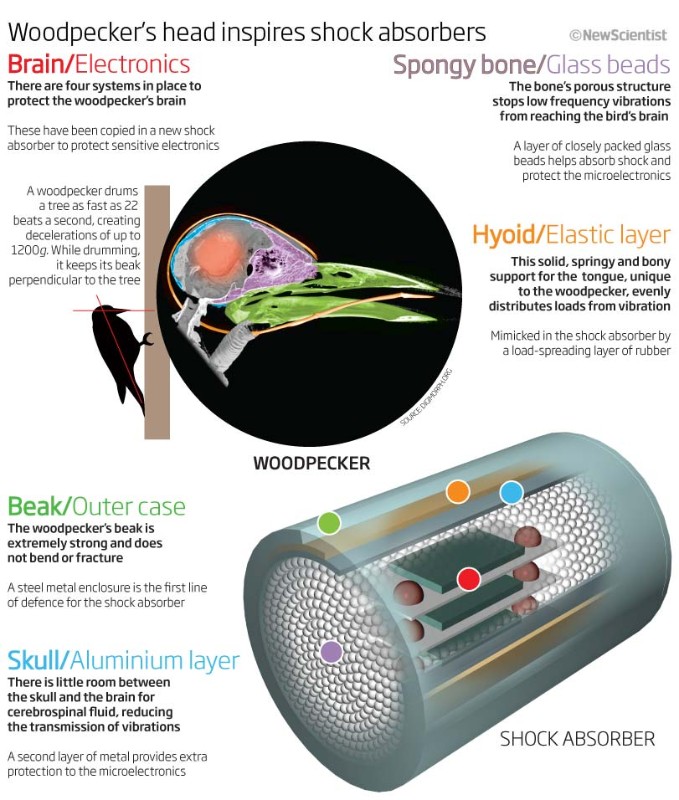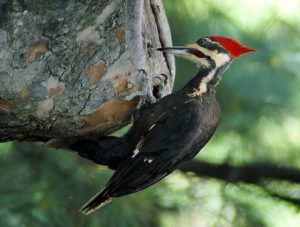Apr
8
Inspired by Woodpeckers
“But ask the animals, and they will instruct you; ask the birds of the sky, and they will tell you.” — Job 12:7 (HCSB)
The other day I was eating lunch out in our sunroom, when I suddenly heard some loud tapping noises on or near the roof. The sounds didn’t last long, fortunately, but I recognized the source: a woodpecker. We sometimes get them on the large tree outside, and I’ve wondered before about how they do what they do. I mean, it’s amazing how one can rapid-fire slam its head — well, its beak — over and over into the trunk or branch of a tree with seemingly no ill effects. If I tried that, I’d be dazed-n-confused after the first head-smack!
So, this time I started to wonder just how the woodpecker was designed for this and if there was something we humans can learn and put to good use. After all, we’ve done that with many other creatures (e.g., surgical glue based on that of the sandcastle worm; chainsaw blade based on the timber beetle’s jaw). The field is called biomimicry or biomimetics: “The study of the structure and function of biological systems as models for the design and engineering of materials and machines.” Sure enough, a quick internet search revealed that woodpeckers are indeed being studied for just this reason, with primary applications being electronics and sports.
Woodpeckers can pound their beaks into trees at anywhere from 18-22 times per second, so their brains experience deceleration forces of 1200-1400g with each blow. (In comparison, a human will get a concussion from a g-force of only 60-100g.) Early research discovered that “thick neck muscles diffuse the blow, and a third inner eyelid prevents the birds’ eyeballs from popping out.” A few years ago, researchers at the University of California – Berkeley identified four additional aspects of the woodpecker’s anatomy that combine to protect the bird from brain damage from such “violence”:
1) a hard-but-elastic beak;
2) a sinewy, springy tongue-supporting structure that extends behind the skull called the hyoid;
3) the way the skull and cerebrospinal fluid interact;
4) a mesh of thick, platelike spongy bone in the skull.
Those researchers, Sang-Hee Yoon and Sungmin Park, wanted to build a mechanical shock-absorbing system to protect microelectronics (e.g., as found in an airplane’s black box), so they set out to develop artificial analogs of each of these four woodpecker features.
To simulate the bird’s infrangible beak, the new shock-absorber’s outer casing consists of a cylindrical, steel metal enclosure. Next comes a layer of rubber that mimics the hyoid’s capacity to evenly distribute vibrational loads. Then, they added a layer of aluminum for extra vibrational reduction. (In the woodpecker, this is done by the skull and a “tight” layer of blood/cerebrospinal fluid. More on this below.) The guts of the shock-absorbent casing functions like the woodpecker’s “spongy bone” area via closely packed, 1-millimeter-diameter glass spheres. This “creates a mesh-like barrier to protect the brain [or, microelectronics] and allows force to be spread evenly after the impact, rather than concentrating in one spot.”
Up to this point, flight recorders could withstand shocks of up to 1000g. Testing of Yoon and Park’s new design demonstrated resistance of up to 60,000g!
As reported by New Scientist‘s Paul Marks,
“As well as a possible role protecting flight recorder electronics, the shock absorber could also be used in “bunker-busting” bombs, as well as for protecting spacecraft from collisions with micrometeorites and space debris. It could also be used to protect electronics in cars.
[According to Kim Blackburn, an engineer at Cranfield University in the UK, which specialises in automotive impact studies,]
‘It may inform our thinking on regenerative dampers for vehicles, redirecting the energy into a form more easily recoverable than dumping it to heat. Ultimately, we need to learn from the woodpecker to recover energy and not give the driver a headache.'”
This research and similar efforts have also inspired scientists to develop better protective gear for sports and other dangerous activities. For example, as noted by Marks, Nick Fry, chief executive of Formula One team Mercedes GP Petronas based in Brackley, UK, is intrigued by the possibilities the new tech could have for protecting race car drivers from injury in accidents. Companies like Brock International are working on improving headgear for NFL players that will (hopefully) cut down on the numbers of brain injuries they suffer.
As explained by Brock’s Kelsey Mullins,
“Woodpeckers prevent brain damage in a fascinating way. Their tongues wrap around jugular veins to increase blood flow to the brain, allowing it to fill the entire skull. The woodpecker’s biology functions much like bubble wrap to protect and insulate the brain from damage. Unlike woodpeckers, the human brain has room to move and floats in cerebral spinal fluid. This allows the brain to “slosh” around, and many concussions are attributed to this movement after impacts or sudden motions occur. Modern helmets prevent most cranial fractures and skull trauma, but can do little to stop traumatic brain injuries that are caused by slosh….
The mechanisms that protect woodpeckers are being imitated to design a snug fitting collar. This collar could be worn by the athlete to put pressure on the jugular vein and increase the blood flow to the brain.”
They are also looking at that unusual, “spongy bone” area in the woodpecker skull in hopes of adapting it, as well.
The most recent discovery I found is of a different nature but worth mentioning here.
A research team out of Boston University, headed by neurobiologist George Farah, published their initial results earlier this year in the journal PLOS ONE. Much to their surprise, the study found a potentially harmful accumulation of a ‘tau’ protein in woodpeckers. Tau is believed to be linked to chronic traumatic encephalopathy (CTE) and other neurodegenerative diseases in humans (including Alzheimer’s). The researchers posit that “there might be an association between repetitive pecking behavior and tau accumulations in the woodpecker population.” Yet, no woodpeckers have been found with brain damage, so how and why would this be?
Of course, evidence of tau was only discovered for sure in 2 out of the 10 woodpecker brains tested in the study. At the end of the paper, the researchers admit:
“There are several limitations to this study. It cannot be concluded at this time the (sic) if the histologic changes identified in our study are the direct result of the repeated, high force pecking woodpeckers endure everyday. The limited number of woodpeckers (n = 10) and control birds (n = 5) utilized in this study are insufficient to established a correlation between pecking behavior and subsequent neurotrauma.”
Sounds like Farah et al. need to do a more comprehensive study with a much larger sample size. Also, as reported by CBC News’s Nicole Mortillaro:
“Not all tau is created equal. Peter Cummings, a neuropathologist at Boston University and one of Farah’s co-authors, explained that some types of the protein are protective, while others accumulate [e.g., after being dislodged by head trauma?] and can become toxic. Could the woodpeckers have the protective form? Or could they have something entirely different that prevents them from suffering neurological repercussions? … The next step will be to find out what kind of type of tau it is or if there’s a binding protein that helps stabilize it [or perhaps dissolves excess accumulations].
‘Answering those two big questions could really help out not just brain injury research but also research into neurodegenerative diseases.'”
All in all, the woodpecker is an amazing creature with some rather ingenious design features that have allowed it to thrive for millions of years. And now, by studying and mimicking this bird, humanity is able to develop some rather impressive designs of our own that will help reduce injury, possibly prevent or treat disease, and save lives.


















